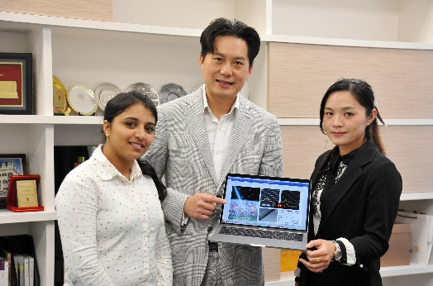NTHU researchers at the vanguard of clean energy
 Using water to generate pollution-free hydrogen energy has long been the dream of energy researchers. With this goal in mind, a research team led by Professor Yen Ta-Jen of the Department of Materials Science and Engineering, has recently found a way to increase the efficiency of water splitting by using a plasmonic nano-antenna incorporated with bilayer molybdenum disulfide (MoS2), thereby boosting the efficiency of hydrogen production by nearly 30 times. Their findings have recently been published in the top journal Advanced Energy Materials and was also highlighted as an inside cover.
Using water to generate pollution-free hydrogen energy has long been the dream of energy researchers. With this goal in mind, a research team led by Professor Yen Ta-Jen of the Department of Materials Science and Engineering, has recently found a way to increase the efficiency of water splitting by using a plasmonic nano-antenna incorporated with bilayer molybdenum disulfide (MoS2), thereby boosting the efficiency of hydrogen production by nearly 30 times. Their findings have recently been published in the top journal Advanced Energy Materials and was also highlighted as an inside cover.
Hydrogen is a clean energy. In the past, it was mainly obtained by electrolyzing water, which is costly. Recently, photoreaction has gradually become the preferred way to split water, but such method is hampered by its low efficiency. Thus researchers worldwide have been searching for a low-cost and high-efficiency catalyst for splitting water.
More recently, a team of Yen's doctoral students has successfully discovered an efficient way to split water for hydrogen evolution reaction and completed a paper entitled "A Plasmonic Nano-antenna with Double-layer Molybdenum Disulfide for High-efficiency Hydrogen Splitting."
Increasing efficiency by eating spinach
Yen explained that when the nano-antenna captures light, it generates a plasmonic oscillation. Plasmons are the collective oscillating behavior of free electrons on a metal-dielectric surface. When the distance between the two metals is on the nanometer scale, the collective oscillation of the electrons strengthens the electrical field, which facilitates the capturing of more light and produce an efficient hydrogen-splitting reaction. "It is like when Popeye the sailor eats spinach!", explained Yen. Once the plasmonic nano-antenna and the double-layer molybdenum disulfide are combined, there is an amazing effect. Yen explained that there are two key points to improving the efficiency of hydrogen splitting. The first is that once the layout of the nano-antenna has been optimized, this optimized nano-antenna can produce a super-strong plasmon with a quadruple reasonance. Second, the large surface-area of molybdenum disulfide makes this method more commercially viable. This research has major implications for the green energy industry
